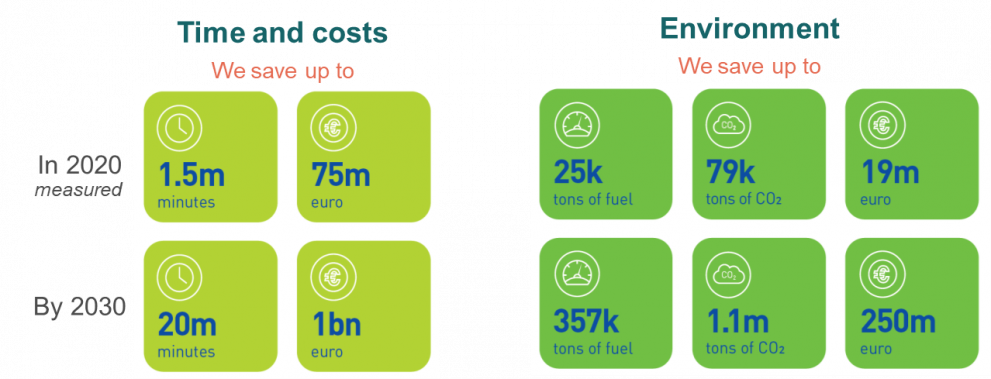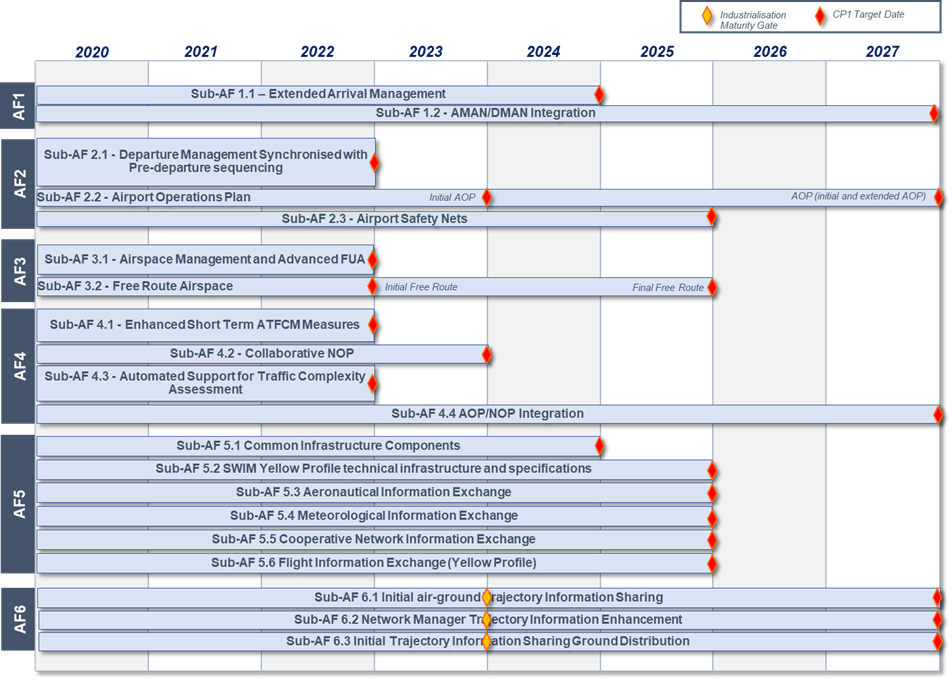Common Projects
Common projects are Commission Implementing Regulations mandating the coordinated and synchronised implementation of specific ATM functionalities for which the underlying operational and technical solutions comply with three criteria:
- they contribute to achieving the “essential operational changes” defined in the European ATM Master Plan;
- they are ready for implementation;
- they require synchronised implementation.
All SESAR solutions, by definition, generate operational benefits for European ATM. However, not all solutions qualify for inclusion in common projects. Common projects in fact include only functionalities that having completed the V4 industrialisation stage, have a very high potential to provide benefits at network level if they deployed in a timely and synchronised manner by multiple ground and air stakeholders from at least two Member States.
Common projects are implemented according to the Deployment Programme established by the Deployment Manager and approved by the Commission. It provides a comprehensive and structured work plan of all activities necessary to implement technologies, procedures and best practices required to implement common projects.
Stakeholders are supported in their efforts to implement common projects through two main mechanisms:
- Deployment governance: involving all the relevant stakeholders and supporting their coordination/synchronisation efforts
- Funding: The Commission may provide deployment governance and the implementation projects with Union funding. However, common projects are not ‘funding programmes’ and their implementation is obligatory regardless of any Union funding. Union financial support aims to encourage early investment from stakeholders and mitigate deployment risks where local cost-benefit analyses are less positive.
The principles governing common projects are set out in the Commission Implementing Regulation (EU) N° 409/2013, amended in 2021 by Regulation (EU) N° 2021/116.
The Pilot Common Project
On 27 June 2014, the Commission adopted the first Common Project (Regulation (EU) N° 716/2014) referred to as the "Pilot Common Project" (PCP). This ‘pilot’ initiative also served as a testbed for the governance and incentive mechanisms supporting the SESAR deployment framework defined in Regulation (EU) N° 409/2013.
The PCP has generated notable results by reducing ATM costs, saving time for passengers and helping to reduce the environmental impact of flights. By the end of 2020, 150 PCP implementation projects, coordinated by the SESAR Deployment Manager, had been completed and the related ATM functionalities had entered into operation.
First results of PCP implementation

The Pilot Common Project review exercise
The Commission has reviewed the implementation of the PCP and of Regulation (EU) N° 409/2013. The review highlighted the positive impact on SESAR deployment, but also the need to address a number of shortcomings in the implementation of the deployment framework. The PCP review is included into the Commission Staff Working Document
.
Common Project One
The PCP has provided significant amount of knowledge and experience in large-scale deployment of ATM solutions. However, the “pilot” phase of the first common project came to its end and the PCP has evolved into “Common Project One” (CP1). CP1 (EU) 2021/116 contains only those ATM functionalities and sub-functionalities that are confirmed to be compliant with the criteria defined in Regulation (EU) N° 409/2013. The aim of these functionalities is to make the European ATM more efficient, reliable and ready for the digital age.
The CP1 continues to mandate the implementation of six ATM functionalities, albeit with a modified list of sub-functionalities. The six ATM functionalities are:
- ‘AF1’ or ‘extended arrival management and integrated arrival management (‘AMAN’)/ departure management (‘DMAN’) in the high-density terminal manoeuvring areas’ improves the precision of the approach trajectory and facilitates air traffic sequencing at an earlier stage and the optimum utilisation of runways, integrating the AMAN and DMAN sequences, by deploying specific ATM solutions.
- ‘AF2’or ‘airport integration and throughput’ facilitates the provision of approach and aerodrome control services by improving runway safety and throughput, enhancing taxi integration and safety and reducing hazardous situations on the runway.
- ‘AF3’ or ‘flexible airspace management and free route airspace’ combines the operation of flexible airspace management and free route and enables airspace users to fly as closely as possible to their preferred trajectory without being constrained by fixed airspace structures or fixed route networks. It allows operations that require segregation to take place safely and flexibly and with minimum impact on other airspace users.
- ‘AF4’ or ‘network collaborative management’ improves the European ATM network performance, notably capacity and flight efficiency, through exchange, modification and management of trajectory information. AF 4 contributes to the implementation of a collaborative network for planning and decision-making, which enables the implementation of flight- and flow-centric operations.
- ‘AF5’ or ‘system wide information management (SWIM)’ consists of standards and infrastructure enabling the development, implementation and evolution of services for information exchange between operational stakeholders via interoperable services which are built on SWIM standards and are delivered through an internet protocol.
- ‘AF6’ or ‘initial trajectory information sharing' or ‘i4D’ improves the use of target times and trajectory information, including where available the use of on-board 4D trajectory data by the ground ATC system and Network Manager systems, implying fewer tactical interventions and improved de-confliction situation.
The CP1 sets specific timeframe for implementing each ATM functionality:

Deployment Manager & Deployment Programme
On 31 May 2022, the SESAR Deployment and Infrastructure Partnership was appointed as the SESAR Deployment Manager, with a mandate running up to 31/12/2027. The Deployment Manager is responsible for the SESAR management level. It has two main roles:
|
Responsible for the Management level |
Coordinator of the Framework Partnership |
|---|---|
|
|
The Deployment Manager delivered the Deployment Programme for the CP1 in 2022. This version has been approved by the Commission on 12 August 2022.
How to contact the Deployment Manager?
- Website: https://www.sesardeploymentmanager.eu/
- Madalina Kramer (Head of Stakeholder Relations and Buy-in SESAR Deployment and Infrastructure Partnership): info
 sesardeploymentmanager [dot] eu (info[at]sesardeploymentmanager[dot]eu)
sesardeploymentmanager [dot] eu (info[at]sesardeploymentmanager[dot]eu)
Related documents
